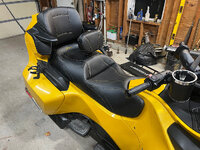Dasmoetorhead
Well-known member
At a given speed, an engine with a less restrictive, "free-flowing" exhaust may be able to maintain that speed at a slightly lower RPM than with a more restrictive, stock exhaust. This is due to the engine producing more power at the same RPM with the upgraded exhaust, allowing the driver to reduce throttle input and, in turn, reduce the engine's RPM while maintaining the same road speed.
How the exhaust affects power and RPM
The relationship between engine RPM, speed, and exhaust system performance is complex, but it can be understood through two key concepts: torque and scavenging.
Torque: At a constant speed, the transmission is in a specific gear, and the engine must produce a certain amount of torque to maintain that speed. An engine with a free-flowing exhaust is more efficient and can produce more power and torque throughout its RPM range, especially at higher RPMs. To maintain the same speed, the car with the upgraded exhaust requires less work from the engine to overcome wind resistance and rolling friction. This allows the driver to back off the throttle, which can result in a lower steady-state RPM for the same speed.
Scavenging: An engine's ability to efficiently expel exhaust gases and draw in fresh air is known as scavenging.
Less restrictive exhaust: A free-flowing exhaust reduces back pressure, making it easier for the piston to push out exhaust gases. This creates a more significant vacuum behind the exiting exhaust pulse, which helps pull the next fresh air/fuel charge into the cylinder.
Low-RPM performance: In some cases, if the exhaust is too large and unrestricted, it can actually reduce exhaust velocity at lower RPMs, which hurts scavenging and can decrease low-end torque. In such a scenario, an engine may feel slightly less responsive at very low speeds or during initial acceleration, though it will perform better at higher RPMs where gas volume is greater. A modern factory exhaust is often tuned to balance low-RPM torque with high-RPM performance.
The net effect
For most driving conditions, a properly designed free-flowing exhaust will slightly increase the engine's efficiency. This will typically result in a slightly lower RPM being needed to sustain a constant speed, as the engine does not need to work as hard. The effect is most noticeable when cruising on the highway, where the reduced back pressure allows the engine to operate more efficiently.
How the exhaust affects power and RPM
The relationship between engine RPM, speed, and exhaust system performance is complex, but it can be understood through two key concepts: torque and scavenging.
Torque: At a constant speed, the transmission is in a specific gear, and the engine must produce a certain amount of torque to maintain that speed. An engine with a free-flowing exhaust is more efficient and can produce more power and torque throughout its RPM range, especially at higher RPMs. To maintain the same speed, the car with the upgraded exhaust requires less work from the engine to overcome wind resistance and rolling friction. This allows the driver to back off the throttle, which can result in a lower steady-state RPM for the same speed.
Scavenging: An engine's ability to efficiently expel exhaust gases and draw in fresh air is known as scavenging.
Less restrictive exhaust: A free-flowing exhaust reduces back pressure, making it easier for the piston to push out exhaust gases. This creates a more significant vacuum behind the exiting exhaust pulse, which helps pull the next fresh air/fuel charge into the cylinder.
Low-RPM performance: In some cases, if the exhaust is too large and unrestricted, it can actually reduce exhaust velocity at lower RPMs, which hurts scavenging and can decrease low-end torque. In such a scenario, an engine may feel slightly less responsive at very low speeds or during initial acceleration, though it will perform better at higher RPMs where gas volume is greater. A modern factory exhaust is often tuned to balance low-RPM torque with high-RPM performance.
The net effect
For most driving conditions, a properly designed free-flowing exhaust will slightly increase the engine's efficiency. This will typically result in a slightly lower RPM being needed to sustain a constant speed, as the engine does not need to work as hard. The effect is most noticeable when cruising on the highway, where the reduced back pressure allows the engine to operate more efficiently.




